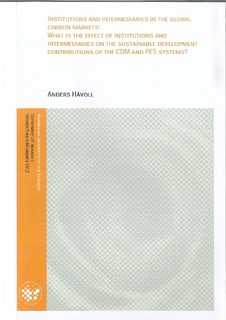| dc.description.abstract | This thesis is about institutions and intermediaries in the global carbon markets. In it I compare two types of financial mechanisms that have the same conceptual basis, but different governance and institutional structures. These two systems are the Clean Development Mechanism (CDM) and payment for environmental services (PES). The CDM is a compliance based system while PES is voluntary. I try to asses the institutional differences between the two systems, and examine how sustainable development (SD) is affected by these differences. I also focus on the roles and motivations of intermediaries operating in the CDM and PES systems by assessing how they affect the SD-contributions of the system they are a part of. In other words I assess how they influence the institutions they are a part of and how they in return are influenced by these institutions.
This thesis, then, has two main parts; one where I analyse the CDM and PES systems – and one where I analyze the roles and motivations of intermediaries in these systems. In the first part of the thesis I attempt to answer the following research question: R1: Do institutional differences between the compliance and the voluntary market lead to a difference in potential SD-contribution of the CDM and PES project systems? I do this by collecting and analysing data from 7532 CDM projects and 1569 PES projects. The data from this total of 9101 projects is sorted according to project type and categorized by how much each project type contributes to sustainable development. This makes it possible to make project distributions that show the aggregate potential SD-contributions of each system. I then analyze the results using a classical institutional economic theory approach. The findings show that the project type distributions between the CDM and PES systems are similar. However, if we split the PES system into two main segments big differences emerge. What I am doing is basically adding another institutional parameter to the way I organize the PES projects. PES projects use different kinds of standards for certification, and the available standards can be separated into two kinds: those that do not require SD-contribution in order to certify, and those that do require SD-contribution in order to certify. Applying this institutional parameter gives us two more project distributions. And these two new distributions differ significantly from each other and from the other two distributions. I argue that this shows that institutional differences lead to a difference in aggregate potential SD-contribution. In the second part of the thesis I analyse how intermediaries affect and are affected by the institutional differences established in the first part of the thesis. I do this by answering the second research question
R2: How do different types of intermediaries contribute to the sustainable development of the projects they are involved in?
To do this I focus on private firm intermediaries working only in the CDM system, private firm intermediaries working only in the PES system and NGO intermediaries working in both the CDM and PES system. Here I have focused on two organizationally similar types of intermediaries (private firms) working in two different systems (CDM and PES), which makes it possible to assess how a difference in institutional context affects the motivations and roles of actors in those contexts. I have also included an organizationally different type of intermediary (NGO) in order to assess whether differences can be attributed to organizational differences rather than institutional differences. The analysis in this part of the thesis is based on a survey. A total of 31 intermediaries responded. Of these 31, 12 where private firm intermediaries in the CDM, 10 where private firm intermediaries in PES, and 9 where NGOs working in both the CDM and PES systems. Unfortunately this was a rather limited number of respondents, so it was not possible to make any conclusive assessments – the results were however encouraging and the tendencies were clear. Basically the results showed that the roles and motivations of intermediaries were affected by the institutional context – and that different types of intermediaries contribute differently to the sustainable development of the projects they are involved in. In general, private firm intermediaries in PES are more motivated by environmental and SD-concerns that their CDM counterparts. Private firm intermediaries in PES and NGO intermediaries in CDM and PES also have a wider variety of motivations than private firm intermediaries in CDM. It was also discovered that intermediaries that specialize in one particular project type (often some kind of forest based project type) had the most direct positive effect on the SD-contribution of the systems. | no_NO |
